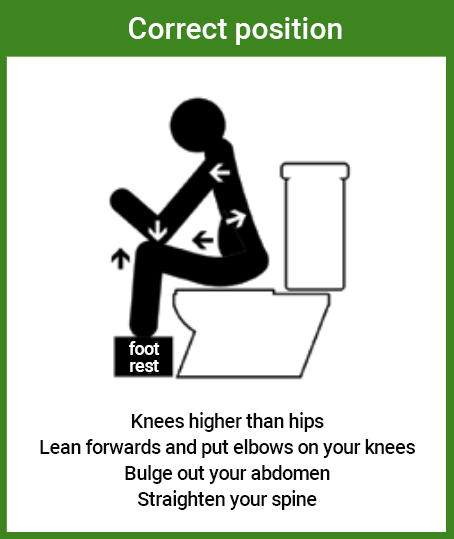Toilet positions To Relieve Constipation
Originally published on: August 10th, 2021. Last modified on February 10th, 2023
Trying to maintain a good toilet position may be useful for people that find it difficult to pass a stool, who strain when the poop won’t come out or who suffer from constipation. There is no right or wrong way to sit on the toilet; however following these pointers may help make emptying your bowels and achieving constipation relief easier, to find the correct toilet position for you.
How to relieve constipation on the toilet
Find the best way to sit on the toilet for you, with these simple pointers.
- Lean forward when you are sitting on the toilet with your hands resting on your thighs
- Make sure that your knees are bent and are higher than your hips (it may help to use a footstool if your toilet is high or you are not very tall)
- Make sure your feet are resting on the ground -(or on a footstool)
- Try to fill your lungs, breathing through your mouth to prevent straining and contracting your pelvic floor (diaphragmatic breathing)
- Bulge your tummy muscles forward as you take a deep breath in. ‘Brace’ your tummy to prevent it from bulging further forwards. Do not tighten your tummy.
- Relax your anal sphincter to open your bottom and let the stool out
- Use your deep breath to increase the pressure in your abdomen and push down towards your anus.
Only try this a maximum of 3 times. If it does not work, get up from the toilet and walk around. It may help to try having a warm/hot drink.
How to sit on the toilet
Remember these four points when sitting on the toilet to help you relieve constipation.
- Keep your knees higher than your hips – a foot stool may help
- Lean forwards, and put your elbows on your knees
- Bulge out your abdomen
- Straighten your Spine

Good toilet habits
In addition to the above guidance, also consider the following each day:
- Don’t put off going to the toilet when you feel the urge as delaying a bowel movement can contribute to constipation.
- Allow yourself plenty of time to sit on the toilet; a good time for this maybe after breakfast or lunch, when your bowels are most active.
- Make sure you sit on the toilet properly (see diagram).
Drink plenty of fluids to keep your body well hydrated – aim for 1.5 to 2 litres of fluid a day, or more in hot weather or if you are exercising.
You may want to read our post on methods of encouraging a bowel movement if the above isn’t working for you. If you struggle to find a toilet when you are out and about, it may also help to have a toilet card. Get the Original Just Can’t Wait Card below.
GET YOUR FREE JUST CAN'T WAIT CARD
FREE Just Can’t Wait Toilet Card
FAQ’s
There are several possible causes for not being able to push your stool out easily: Constipation. Faecal impaction means you feel the need to pass stool, but you are unable to do so due to dietary habits and lifestyle choices.
Faecal impaction or constipation can cause stools to get stuck halfway out. If you are experiencing this problem whilst on the toilet, it’s worth making sure you are sitting on the toilet in the correct position. Alternatively, you can pass a hard stool by walking around, drinking water, or taking a laxative before you try.
Follow these 4 simple steps to relieve the symptoms of constipation and pass stool easily.
- Keep your knees higher than your hips – a foot stool may help with this
- Lean forwards and put your elbows on your knees
- Bulge out your abdomen
- Straighten your spine
Incomplete evacuation refers to the sensation that one’s bowel movement has not been completed, even if it has been. This means your pelvic and anal muscles aren’t coordinated well. This may also be a symptom of irritable bowel syndrome or ulcerative colitis so you should seek medical advice if this persists.
Make sure you do not try to push out the poop right away. You should give your body about 5 minutes to get things going before you start pushing. Toilet training can sometimes lead to other issues, such as piles and stress on pelvic tissues, which is why it’s advised to try sitting in the correct toilet position to avoid excessive straining.
It is rare for constipation to cause complications for most people. However, those who suffer long-term constipation risk developing: haemorrhoids (piles), faecal impaction (where dry, hard stools accumulate in the rectum), and bowel incontinence (the leakage of liquid stools). It’s always best to contact your GP or medical professional for advice.
You may want to read our post on methods of encouraging a bowel movement if the above isn’t working for you. If you struggle to find a toilet when you are out and about, it may also help to have a toilet card. Get the Original Just Can’t-Wait Card below.
